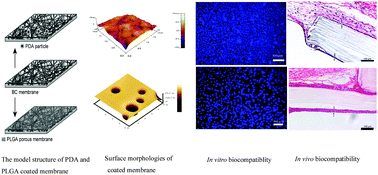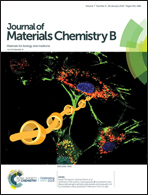Comparative evaluation of the biocompatible and physical–chemical properties of poly(lactide-co-glycolide) and polydopamine as coating materials for bacterial cellulose†
Abstract
The aim of this study was to investigate the influence of poly(lactide-co-glycolide) (PLGA) and polydopamine (PDA) as coating materials on the tensile strength, surface performance, in vitro cell behavior and the in vivo material-tissue reaction of bacterial cellulose (BC) membranes. The coated membranes were characterized by Fourier transform infrared spectroscopy (FTIR), X-ray photoelectron spectroscopy (XPS), atomic force microscopy (AFM) and scanning electron microscopy (SEM), demonstrating that the PDA forms the dispersion phase and penetrates into the BC substrates while PLGA only adheres to the BC surface. Mechanical tests and fractured surface morphology reveal that penetration of PDA into BC membranes enhances the mechanical strength by strongly bonding the nanofibers. The PLGA coated BC membrane obtained by adhesion debonds from the BC substrate under stress, leading to a decrease in the mechanical strength of the membrane. The in vitro cell culture experiments were established to assess cell attachment and spreading by SEM and DAPI (4′,6-diamidino-2-phenylindole) staining and expression of collagen I, which showed a better performance on the PDA-BC than on the PLGA-BC and bare BC membranes. However, the in vivo results of the rabbit back implantation indicated that BC membrane surface modification by PDA is not effective for cell proliferation and collagen accumulation when compared to bare and PLGA coated BC, whereas PLGC-BC were surrounded by a thicker layer of connective tissues with slight neovascularization demonstrating superior tissue integration. PDA based materials still have a long way to go before clinical applications. However, PLGA coating has excellent biocompatibility in clinical as well as in experimental use.



 Please wait while we load your content...
Please wait while we load your content...